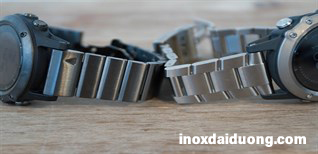Are you looking for a new watch or a piece of jewelry but contemplating the choice between 316L Stainless Steel and Titanium? This blog post will help you make an informed decision. Dive in to explore the characteristics of both materials and determine which one is better with your requirements.
Nội dung chính
What is 316L Stainless Steel?
316L Stainless Steel is one of the most popular materials in watches and jewelry owing to its durability and minimal maintenance needs. Its high resistance to corrosion and rust makes it an excellent option, particularly for individuals residing in humid climates area. Being a stainless steel product, it also resists tarnishing, reducing the need for frequent polishing or cleaning. The “L” in “316L” denotes low carbon content, achieved through an electrochemical process that enhances its corrosion resistance.
See more:
What is Titanium?
Titanium is a lightweight metal with an exceptional strength-to-weight ratio, known for its durability and resistance to corrosion. However, it lacks the malleability of metals like gold or silver, making it more challenging and expensive to work with when crafting jewelry or watches. Titanium is prone to scratches, which can be polished out, though some cases might require professional attention.
Difference between 316l stainless steel and titanium
Cost:
Titanium is considerably more expensive than 316L stainless steel. This price difference arises from titanium being a rarer metal and requiring more effort in the extraction process compared to stainless steel.
Strength:
Titanium exhibits superior strength compared to 316L stainless steel. Its higher tensile strength enables it to withstand high force before breaking.
Weight:
Titanium is significantly lighter than 316L stainless steel, thanks to its lower density. This characteristic makes it ideal for applications where weight is a crucial factor, such as aircraft construction.
Corrosion Resistance:
Titanium is better corrosion resistance than 316L stainless steel. It is less prone to rust or corrosion when exposed to moisture or other chemicals.
Biocompatibility:
Titanium is more biocompatible, compared to 316L stainless steel, making it less likely to cause allergic reactions in individual sensitive to metals
Conclusion
When deciding between 316L stainless steel and titanium for your next watch or piece of jewelry, various factors need to consider. Both materials are durable and corrosion-resistant, but titanium offers greater strength, while 316L stainless steel demands less maintenance due to its low carbon content. Ultimately, your choice should align with personal preferences, considering the desired look and feel you want from your watch or jewelry.
OSS Dai Duong contact details:
- Hotline: 1800 6968
- Fanpage: Dai Duong Stainless Steel
Editorial board: O S S Dai Duong




